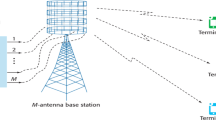Abstract
In this paper, we analyze the ergodic achievable rate of an uplink massive multi-user multipleinput multiple-output (MIMO) system with a large and Poisson distributed number of users. In the considered scenario, multiple user equipments (UEs) transmit their information to a base station equipped with a very large number of antennas. New asymptotic expressions for the ergodic achievable rate for large and deterministic number of users are derived for both maximum ratio combining (MRC) detector and zero-forcing (ZF) detector, as well as the ergodic achievable rate for large and random number of users. Simulation results assess the accuracy of these analytical expressions. It is shown that compared with the MRC detector, ZF detector can achieve much higher spectrum efficiency. Also, the results provide a meaningful fact that with different settings the randomness of the number of users will result in different extents of impact on the performance of massive MIMO.
创新点
在本文中,我们分析了服务大数目随机用户的上行大规模天线系统的遍历可达速率。在该场景中,多个用户发送信息至一个装备大量天线的基站。对于固定数目和随机数目的用户,我们分别给出了采用最大比合并接收机和迫零接收机时的遍历可达速率。仿真结果说明了我们理论推导的准确性。与最大比合并接收机相比,迫零接收机能给系统带来更高的频谱效率。此外,随机用户数目的不同设置也会给大规模天线系统的性能带来不同的影响。
Similar content being viewed by others
References
Osseiran A, Boccardi F, Braun V, et al. Scenarios for 5G mobile and wireless communications: The vision of the METIS project. IEEE Commun Mag, 2014, 52: 26–35
Jungnickel V, Manolakis K, Zirwas W, et al. The role of small cells, coordinated multipoint, and massive MIMO in 5G. IEEE Commun Mag, 2014, 52: 44–51
Telatar E. Capacity of multi-antenna Gaussian channels. Eur Trans Telecomm, 1999, 10: 585–596
Jing Y, Hassibi B. Distributed space-time coding in wireless relay networks. IEEE Trans Wirel Commun, 2006, 5: 3524–3536
Zhang Z S, Zhang W, Tellambura C. MIMO-OFDM channel estimation in the presence of frequency offsets. IEEE Trans Wirel Commun, 2008, 7: 2329–2339
Sibille A, Oestges C, Zanella A. MIMO: from Theory to Implementation. New York: Academic Press, 2010
Cui Q M, Huang X Q, Luo B, et al. Capacity analysis and optimal power allocation for coordinated transmission in MIMO-OFDM systems. Sci China Inf Sci, 2012, 55: 1372–1387
Wang D M, Wang J Z, You X H, et al. Spectral efficiency of distributed MIMO systems. IEEE J Sel Areas Commun, 2013, 31: 2112–2127
Wu Y, Zheng M, Fei Z S, et al. Outage probability analysis for superposition coded symmetric relaying. Sci China Inf Sci, 2013, 56: 022307
Xing C W, Fei Z S, Li N, et al. Statistically robust resource allocation for distributed multi-carrier cooperative networks. Sci China Inf Sci, 2013, 56: 109–121
Fei Z S, Ni J Q, Zhao D, et al. Ergodic secrecy rate of two-user MISO interference channels with statistical CSI. Sci China Inf Sci, 2014, 57: 102302
Fei Z S, Ding H C, Xing C W, et al. Performance analysis for range expansion in heterogeneous networks. Sci China Inf Sci, 2014, 57: 082305
Marzetta T L. Noncooperative cellular wireless with unlimited numbers of base station antennas. IEEE Trans Wirel Commun, 2010, 9: 3590–3600
Rusek F, Persson D, Lau B K, et al. Scaling up MIMO: opportunities and challenges with very large arrays. IEEE Signal Process Mag, 2013, 30: 40–46
Wang D M, Ji C, Gao X Q, et al. Uplink sum-rate analysis of multi-cell multi-user massive MIMO system. In: Proceedings of IEEE International Conference on Communications, Budapest, 2013. 5404–5408
Zhang J, Wen C K, Jin S, et al. On capacity of large-scale MIMO multiple access channels with distributed sets of correlated antennas. IEEE J Sel Areas Commun, 2013, 31: 133–148
Ngo H Q, Larsson E G, Marzetta T L. Energy and spectral efficiency of very large multiuser MIMO systems. IEEE Trans Commun, 2013, 61: 1436–1449
Artigue C, Loubaton P. On the precoder design of flat fading MIMO systems equipped with MMSE receivers: a large system approach. IEEE Trans Inf Theory, 2011, 57: 4138–4155
Pitarokoilis A, Mohammed S K, Larsson E G. On the optimality of single-carrier transmission in large-scale antenna systems. IEEE Wirel Commun Lett, 2012, 1: 276–279
Huh H, Caire G, Papadopoulos H C, et al. Achieving massive MIMO spectral efficiency with a not-so-large number of antennas. IEEE Trans Wirel Commun, 2012, 11: 3226–3239
Datta T, Kumar N A, Chockalingam A, et al. A novel Monte Carlo sampling based receiver for large-scale uplink multiuser MIMO systems. IEEE Trans Veh Technol, 2013, 62: 3019–3038
Hoydis J, Brink S T, Debbah M. Massive MIMO in UL/DL cellular systems: how many antennas do we need? IEEE J Sel Areas Commun, 2013, 31: 160–171
Yang H, Marzetta T L. Performance of conjugate and zero-forcing beamforming in large-scale antenna systems. IEEE J Sel Areas Commun, 2013, 31: 172–179
Fernandes F, Ashikhmin A, Marzetta T L. Inter-cell interference in noncooperative TDD large scale antenna systems. IEEE J Sel Areas Commun, 2013, 31: 192–201
Cao J, Wang D M, Li J M, et al. Uplink sum-rate analysis of massive MIMO system with pilot contamination and CSI delay. Wirel Pers Commun, 2014, 78: 297–312
Li J M, Wang D M, Zhu P C, et al. Spectral efficiency analysis of single-cell multi-user large-scale distributed antenna system. IET Commun, 2014, 8: 2213–2221
Kingman J. Poisson Processes. Oxford: Oxford University Press, 1993
Goldsmith A. Wireless Communications. Cambridge: Cambridge University Press, 2005
Tse D, Viswanath P. Fundamentals of Wireless Communication. Cambridge: Cambridge University Press, 2005
Park E, Lee S R, Lee I. Antenna placement optimization for distributed antenna systems. IEEE Trans Wirel Commun, 2012, 11: 2468–2477
Choi W, Kim J Y. Forward-link capacity of a DS/CDMA system with mixed multirate sources. IEEE Trans Veh Technol, 2001, 50: 737–749
Cramér H. Random Variables and Probability Distributions. Cambridge University Press, 1970
Gradshteyn I S, Ryzhik I M. Table of Integrals, Series, and Products, 7th ed. New York: Academic Press, 2007
Author information
Authors and Affiliations
Corresponding author
Rights and permissions
About this article
Cite this article
Yang, A., Xing, C., Fei, Z. et al. Performance analysis for uplink massive MIMO systems with a large and random number of UEs. Sci. China Inf. Sci. 59, 1–9 (2016). https://doi.org/10.1007/s11432-015-5435-2
Received:
Accepted:
Published:
Issue Date:
DOI: https://doi.org/10.1007/s11432-015-5435-2
Keywords
- massive MIMO
- large numbers of UEs
- maximum ratio combining detector
- zero-forcing detector
- ergodic achievable rates




